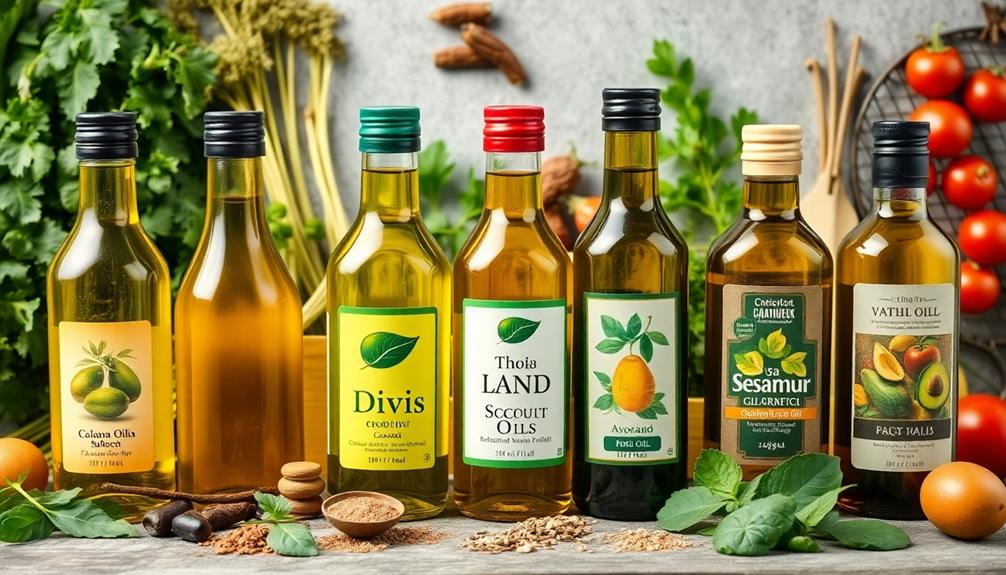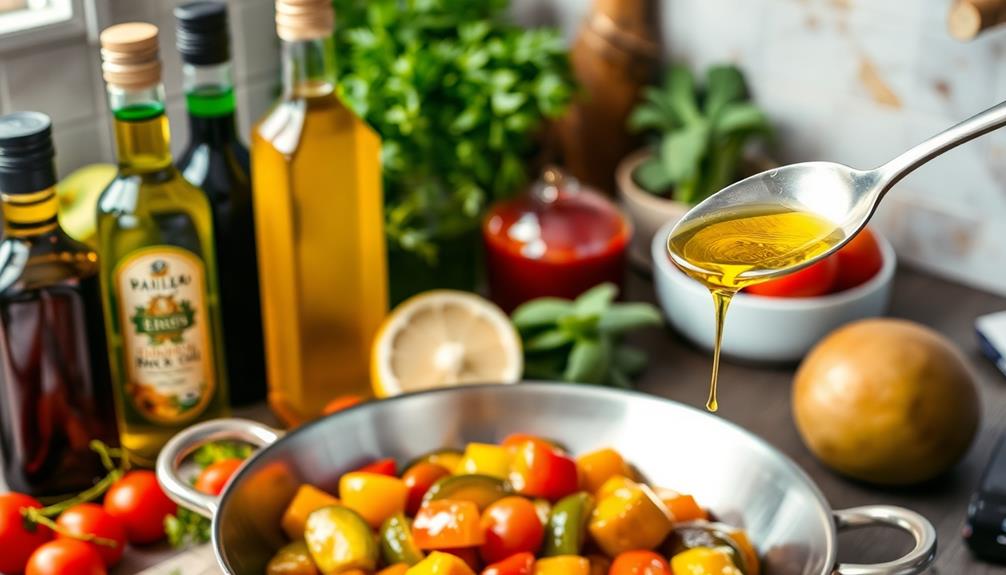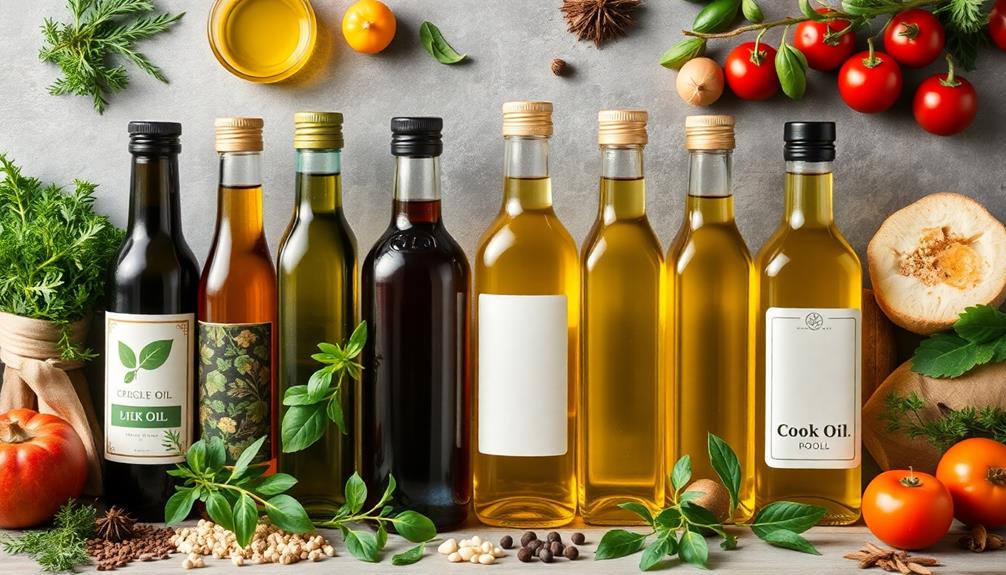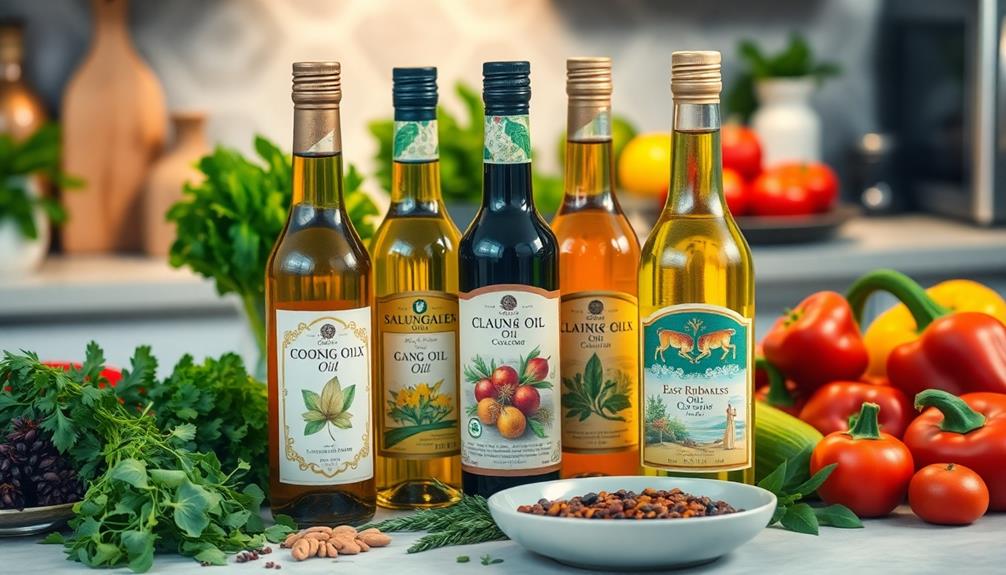Different cooking oils can transform your dish's flavor. For instance, olive oil brings a rich, fruity essence, making it perfect for Mediterranean meals. Coconut oil adds a sweet, nutty note that works beautifully in vegan baking. If you're looking for a mild flavor, avocado oil is a great choice, suitable for high-heat cooking without overpowering other ingredients. On the other hand, canola and grapeseed oils offer neutral tastes, seamlessly blending into various recipes. Each oil has its uniqueness, impacting your meals in delightful ways. There's more to discover about these oils and their culinary roles!
Key Takeaways
- Different cooking oils have unique flavor profiles; for instance, olive oil is fruity, while coconut oil adds sweetness.
- High-heat oils like avocado and peanut oil maintain their flavors during frying, enhancing dishes without overpowering them.
- Oils like sesame and peanut oil are ideal for specific cuisines, providing distinct flavors that complement Asian dishes.
- Neutral oils, such as canola and grapeseed, blend seamlessly into recipes, allowing other ingredients to shine without altering flavor.
- Proper storage of oils is essential to prevent rancidity and maintain their intended flavors, especially for light-sensitive oils like olive oil.
Overview of Cooking Oils

When it comes to cooking oils, variety is key. Each type of cooking oil brings its own unique flavor profiles that can elevate your dishes. For instance, olive oil has a strong, fruity taste that pairs beautifully with Mediterranean recipes, while coconut oil offers a sweet, nutty flavor perfect for baked goods.
In Brazilian cuisine, oils are often used to enhance the rich flavors of dishes like Caldeirada, showcasing the importance of ingredient selection. If you're looking for a versatile option, avocado oil's mild buttery flavor works well for high-temperature cooking and dressings.
Peanut oil, with its subtle nutty taste, enhances the flavors of Asian cuisine, and sesame oil, known for its robust flavor, is a staple in many Asian dishes. Walnut oil provides a rich, nutty taste that shines in salads or as a finishing touch.
On the other hand, grapeseed and canola oils are neutral in flavor, making them ideal for blending seamlessly into various dishes without altering their taste profile.
Choosing the right cooking oil can greatly impact your dish's overall flavor. By understanding each oil's unique characteristics, you can enhance or complement specific ingredients and cooking methods, ensuring your meals are as delicious as possible.
Flavor Profiles of Common Oils

When you choose a cooking oil, its unique flavor characteristics can really enhance your dishes. Each oil has specific applications and pairings that can elevate your meals, whether you're baking, frying, or dressing a salad.
For instance, using oils derived from nuts or seeds can add a rich, nutty flavor that complements dishes like a Grilled Peach and Burrata Salad.
Let's explore how these common oils can transform your cooking experience.
Unique Flavor Characteristics
Have you ever wondered how different cooking oils can transform the flavor of your dishes? Each oil comes with its own unique flavor characteristics that can elevate your cooking. For instance, olive oil adds a fruity and robust taste, perfect for drizzling over salads or enhancing Mediterranean dishes, while sesame oil brings a nutty depth ideal for stir-fries and Asian cuisine. The choice of oil often depends on the cooking methods and flavor compounds you’re aiming to highlight in your dish. Understanding these nuances can help you pair the right oil with your recipe, unlocking a whole new dimension of taste.
For instance, extra-virgin olive oil boasts a rich, fruity flavor that enhances Mediterranean dishes, while its refined counterpart offers a milder taste suitable for versatile cooking methods. Similarly, when preparing dishes like Mushroom Masala, the choice of oil can greatly alter the dish's overall flavor profile, enhancing the earthy notes of the mushrooms.
Coconut oil adds a sweet, nutty flavor, which is perfect for vegan baking and tropical recipes, although it can sometimes overshadow other tastes due to its high saturated fat content.
On the other hand, avocado oil presents a mild, buttery flavor that blends seamlessly into both high-heat cooking and dressings without overpowering other ingredients.
Peanut oil, known for its distinct nutty flavor, is a staple in Asian cuisine, especially for frying, adding depth to your dishes without being too strong.
Finally, sesame oil delivers a strong, unique flavor, particularly in its unrefined form, making it an excellent choice for stir-fries and salads.
Cooking Applications and Pairings
Cooking with the right oil can make all the difference in your dishes, and understanding the flavor profiles of common oils helps you choose the best one for each application.
For instance, using peanut oil can enhance the flavors of dishes like Red-Braised Pork Belly when stir-fried, as its nutty undertones complement rich meats beautifully.
Here's a quick guide on how to pair oils with your cooking needs:
- Olive Oil: Perfect for Mediterranean dishes, dressings, and cold applications. Its robust, fruity flavor shines in salads.
- Canola Oil: Its mild taste is versatile, making it ideal for baking and frying without altering your dish's flavor profile.
- Coconut Oil: Adds a subtle sweetness, great for vegan baking and Asian cuisine. Just be mindful of its saturated fat content.
- Peanut Oil: With a nutty flavor and high smoke point, it's excellent for deep frying and stir-frying, especially in Asian dishes.
When selecting an oil, consider how its flavor will complement your recipe.
For high-heat cooking, opt for avocado oil, which has a buttery flavor and works well without overpowering other ingredients.
Health Benefits of Cooking Oils

Exploring the health benefits of various cooking oils reveals a range of advantages that can enhance your overall well-being.
For instance, olive oil is packed with monounsaturated fats and polyphenols, both of which are linked to a reduced risk of heart disease and improved cardiovascular health. Additionally, using olive oil in traditional dishes like Agnolotti not only enhances flavor but also supports heart health.
Canola oil, rich in omega-3 fatty acids, can aid in brain health and help reduce inflammation in your body.
Meanwhile, coconut oil, although high in saturated fat, contains medium-chain triglycerides that may boost your metabolism and provide quick energy.
Avocado oil stands out with its high vitamin E content and antioxidants, promoting skin health and offering anti-inflammatory effects that can be beneficial for your overall wellness.
Cooking Techniques and Applications

When you're cooking, choosing the right oil can make all the difference in both flavor and technique. High-heat oils like avocado and peanut oil are perfect for frying, while flavored oils can elevate your dishes with just a drizzle.
For instance, using a splash of oil when preparing a classic Southern dish like squash casserole can enhance its richness and flavor profile.
Let's explore how to pair oils effectively and enhance your cooking with the right techniques.
High-Heat Cooking Oils
High-heat cooking oils play an essential role in achieving perfect textures and flavors in your dishes. When you're frying or sautéing, you need oils that can withstand high temperatures without breaking down. Selecting oils with a high smoke point guarantees your food cooks evenly without compromising taste.
For instance, when preparing dishes like Hiyashi Chuka (Cold Ramen), using the right oil can enhance the overall flavor profile.
Here are some excellent choices for high-heat cooking:
- Avocado oil: With a smoke point of 520°F, it's perfect for frying and adds a rich flavor.
- Peanut oil: At 450°F, it's great for stir-frying and imparts a subtle nuttiness.
- Canola oil: This versatile oil has a smoke point of 400°F, making it ideal for various cooking methods without strong flavors.
- Sunflower oil: With a smoke point of 440°F-450°F and a neutral flavor, it won't alter your dish's taste.
Coconut oil, while lower at 350°F, offers a sweet and nutty flavor, particularly in vegan recipes.
When choosing oils for high-heat cooking, aim for those with low polyunsaturated fat content to minimize harmful compounds. This way, you can enhance your cooking experience without risking your health.
Flavor Enhancement Techniques
Often, the right cooking oil can transform a dish, enhancing its flavor and elevating your culinary creations. Different oils have unique flavor profiles that can greatly impact your meals. For instance, extra-virgin olive oil offers a robust, fruity taste, perfect for dressings, while sesame oil adds a rich nuttiness that complements Asian dishes beautifully.
Similarly, the use of oils can enhance traditional Mexican dishes, such as drizzling some chile oil over chilaquiles for an extra kick.
When you're using high-heat cooking methods, opt for oils with neutral flavors, like canola or sunflower oil. These won't overpower your main ingredients, allowing their natural tastes to shine. If you want to add depth, consider using infused oils, such as garlic or chili oil. These can serve as a delightful finishing touch on salads and grilled meats, enhancing your dish's complexity.
Moreover, achieving flavor harmony is essential in cooking. For instance, avocado oil's mild buttery flavor pairs well with Latin American dishes, while peanut oil's nutty undertones are ideal for many Asian recipes.
Oil Pairing Suggestions
Selecting the right oil for your cooking technique can elevate your dishes even further. Different cooking oils bring unique flavor profiles and properties to the table, so pairing them wisely can enhance your culinary creations. For instance, you can experiment with different oils when preparing spooky Halloween snacks that require a flavorful touch.
- Olive Oil: Perfect for Mediterranean dishes, dressings, and marinades, it elevates salads and pasta sauces with its robust flavor.
- Avocado Oil: With a mild, buttery flavor and a high smoke point, it's fantastic for roasting and frying, and it complements dressings beautifully.
- Sesame Oil: Its distinct nutty flavor shines in Asian cuisines, especially in stir-fries or as a finishing oil for salads.
- Coconut Oil: Ideal for baking and desserts, particularly vegan recipes, it's also versatile for sautéing.
For deep-frying and crafting Asian dishes, consider peanut oil, as its mild to nutty flavor and high smoke point enhance the taste of fried foods.
Smoke Points and Cooking Methods

Understanding an oil's smoke point is essential for successful cooking, as it directly impacts flavor and nutritional quality. For instance, when preparing traditional dishes like Kue Putu, the choice of oil can greatly influence the final taste.
Oils with high smoke points, like avocado oil at 520°F, are perfect for high-heat cooking methods such as frying. When you fry, using oils like peanut oil (450°F) or sunflower oil (440°F-450°F) guarantees stability and prevents burning, delivering great flavor profiles without compromise.
On the other hand, oils with low smoke points, such as flaxseed oil (225°F), should be reserved for cold applications like dressings. Heating these oils can lead to off-flavors and the formation of harmful compounds.
When sautéing, opt for moderate heat oils like olive oil, which has a smoke point between 375°F and 470°F. This choice not only enhances the dish's flavor but also offers health benefits.
Storage Tips for Cooking Oils

Proper storage of cooking oils is key to preserving their flavor and nutritional quality. To keep your oils fresh and flavorful, follow these storage tips:
- Store oils in a cool, dark place to prevent oxidation and rancidity.
- Use dark glass bottles or tins for olive oil to protect it from light exposure.
- Refrigerate flaxseed oil and use it within 6-12 months after opening.
- Keep coconut oil away from heat sources, even if it remains solid at room temperature.
Each type of oil has its own shelf life and requires attention. Olive oil can degrade in flavor if exposed to light, while flaxseed oil is particularly sensitive and should be refrigerated.
Coconut oil has a longer shelf life of about two years, but heat can still compromise its integrity.
Always check the expiration date on your cooking oils. If you use them infrequently, consider transferring smaller portions into smaller containers to minimize the risk of spoilage.
Selecting the Right Oil

Choosing the right cooking oil can greatly enhance your dishes, and it's often a decision you make more frequently than you realize. Different cooking oils come with unique flavor profiles that can elevate your meals. For instance, extra-virgin olive oil offers a fruity taste, while coconut oil adds subtle sweetness.
When selecting the right oil, consider the dish's flavor requirements. If you're preparing Asian cuisine, sesame oil brings a rich, nutty flavor, whereas grapeseed oil serves as a neutral option for various applications.
Don't overlook the smoke point; oils like avocado oil have a high smoke point, making them ideal for frying without compromising flavor. In contrast, flaxseed oil's lower smoke point limits its use to dressings.
Versatile oils, such as canola oil, are perfect for baking and frying without altering your dish's inherent taste. Additionally, experimenting with flavored oils, like garlic-infused olive oil or chili oil, can add complexity and depth.
Enhancing Dishes With Oils

Elevating your dishes with the right cooking oils can transform an ordinary meal into a culinary delight. Each type of oil offers a unique flavor profile that can enhance your cooking in remarkable ways.
For instance, extra virgin olive oil adds a fruity and peppery finish, perfect for Mediterranean dishes. Sesame oil brings a nutty essence that elevates Asian cuisines, while canola oil's mild flavor allows other ingredients to shine.
Consider these oils to enhance your dishes:
- Coconut oil: Adds a subtle sweetness, ideal for baking and vegan recipes.
- Avocado oil: Provides a buttery richness that enhances roasted vegetables beautifully.
- Walnut oil: Offers a strong, nutty flavor, perfect for salad dressings.
- Flavored oils: Such as truffle oil, infuse gourmet notes into pasta and risotto.
Frequently Asked Questions
Do Different Oils Make Food Taste Different?
Yes, different oils absolutely make food taste different. Each oil brings unique flavors and aromas, enhancing your dishes. By experimenting with various oils, you can discover delightful combinations that elevate your culinary creations to new heights.
Can You Taste the Difference Between Vegetable Oil and Canola Oil?
Imagine two whispering friends in your kitchen—vegetable oil's neutrality and canola oil's subtle nuttiness. You can taste the difference, especially in dressings where canola's flavor dances just a bit more, enhancing your dish beautifully.
Does Different Cooking Oil Make a Difference?
Yes, different cooking oils absolutely make a difference. Each oil brings its unique flavor, enhancing your dishes. Choosing the right oil elevates your cooking, allowing you to create a more delicious and satisfying culinary experience.
Which Cooking Oil Has the Least Taste?
If you're looking for a cooking oil with the least taste, canola oil and sunflower oil are great choices. They're neutral and won't interfere with your dish's flavors, making them versatile for various recipes.
Conclusion
In the world of cooking, the right oil can truly elevate your dishes, adding a subtle touch that dances on the palate. By understanding how different oils influence flavor profiles and knowing their unique benefits, you can make informed choices that enhance your culinary creations. So, don't just settle for any oil—choose wisely, and let your meals shine with a hint of sophistication. After all, a little drizzle can transform an ordinary dish into something extraordinary.










